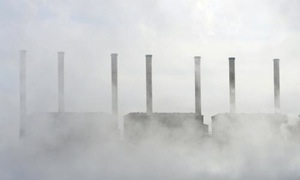
Australia’s power generation and transport fuel use will be left to the market to decide, the Abbott government says in its long-awaited energy white paper, which does not discuss climate change as a driver of energy policy.
The government promises a hands-off “technology neutral” approach to the electricity market and the future of transport fuels, saying it will not try to shut down old coal-fired power plants or push new technologies into the market to try to reduce greenhouse emissions.
Unlike the former Labor government’s 2012 white paper, which predicted rising gas exports but also a domestic switch from fossil fuels to renewables, or John Howard’s 2004 white paper which devoted an entire chapter to the impact of climate change on energy policy, the Abbott government’s 2015 white paper mentions climate change just once, and does not see emissions reductions as an energy policy goal.
“Investment decisions on future (electricity) generation assets, including choice of technology, are best made by industry, given its insights into market needs. The Australian government will seek to maintain stable and predictable policy settings across the range of areas that affect such investment decisions, while taking a technology-neutral approach,” the energy white paper says.
“The Australian government will not be pursuing policies to ‘pay’ for exit of surplus generation capacity. This could unfairly shift costs onto either consumers or taxpayers.”
The government is not planning on pushing alternative transport fuels either, saying “consistent with approaches elsewhere in the energy sector, the Australian government prefers to not intervene in a way that promotes one technology over another or forces technologies that are not cost competitive into the market at a cost to consumers or taxpayers”.
The renewable energy target – requiring 41,000 gigawatt hours of renewable energy by 2020 – would be an exception to this rule, but the white paper restates the government’s negotiating position on the current target, for which it has yet to win necessary support from either the Labor party or the required number of crossbench senators.
It acknowledges that Australia’s “low-cost” fossil fuel electricity generation is responsible for one third of its greenhouse gas emissions and that new technologies can have lower emissions – but says it is not up to governments to push them.
“Without commercially available and cost competitive low emissions fossil fuel technologies, there is a growing long-term risk for our fossil fuel export industry in an emissions constrained future,” it says.
“Changes in Australia’s energy mix can emerge quickly, with the most recent example being the rapid uptake of solar PV … New energy sources and technologies can increase the flexibility and sustainability of the energy system, as well as help lower emissions and provide potential export opportunities.
“However, the cost competitiveness of new technologies typically improves as production efficiencies evolve. Ongoing product improvements also typically follow product maturity. Prematurely forcing new technologies in the energy market through policy interventions runs the risk of early adoption coming at a higher cost and lower efficiency than if that product found its way into the market on a competitive basis.”
The paper acknowledges Australia could benefit from new technologies that reduce emissions from fossil fuel generation, citing “the Australian black coal industry” as “the only industry in the world to voluntarily put a levy on production to fund work related to the demonstration of low emissions coal technology solutions”.
In fact the coal industry “paused” the levy on black coal producers, which was supposed to build a $1bn industry fund to also finance research and demonstration into clean coal technology. It cited low coal prices for the halt.
The white paper also cites the investments made by the Australian Renewable Energy Agency and the Clean Energy Finance Corporation, both of which the government has unsuccessfully sought to abolish.
Other major points in the white paper include:
- the government would be happy for power retailers to proceed with “cost-reflective electricity tariffs” which could lower power prices for savvy consumers but increase them for others – but on a voluntary basis
- it remains opposed to “reserving” gas fields for domestic use to try to stop price rises, because this would be like a tax on the production of LNG
- it will explain by the end of the year what it intends to do about the multi-billion dollar investment that will be required to fix the problem of Australia’s oil stockpiles remaining below internationally required levels
- the government wants to use South Australia’s royal commission on the nuclear industry to start an “informed community discussion”
- it backs the “responsible” development of coal seam gas, but says companies need to “engage” with local communities
The government says it is “committed to cost-reflective tariffs” because “consumers should be charged according to the actual costs of their energy use, including the costs of delivering energy at the time they use it and the full value of a permanent connection to a reliable energy supply” and it would like to see an end to cross-subsidies – like the extra costs borne by all power users for the poles and wires needed to deliver power to people using air-conditioners on hot days.
Ending such cross-subsidies would require smart meters and consumer education, because those now being subsidised could end up with much higher bills, and the paper says this process should be voluntary and led by the market rather than forced by government.
The paper says Australia’s current oil stockholdings do not meet International Energy Agency obligations, which would require “an investment of several billion dollars in stocks and storage infrastructure over a decade. A decision on how to address this compliance issue will be made by the government in 2015”.
Julia Gillard also hailed a deal with the premiers for “voluntary” roll-out of time of use pricing, but there has been little progress.
